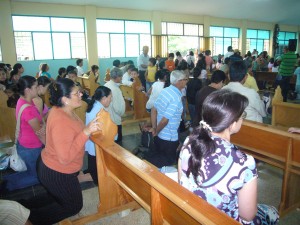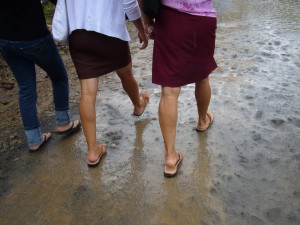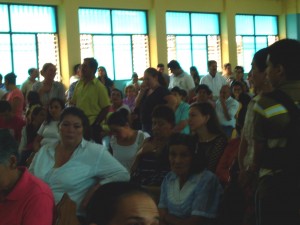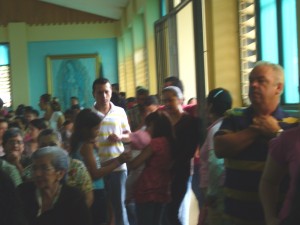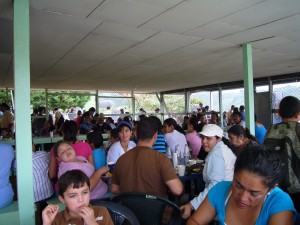The first time I visited Costa Rica, on George Lundquist’s tour, retirement for the non-rich, one of the sights I saw was the Basílica de Nuestra Señora de Los Ángeles, in Cartago. George had lots of cool stories to tell us on the 4-day tour, and some of them were even true. One of the stories he shared was about the building of the famous basilica.
Back in 1635, George said, a little girl found a statue of a dark-complexioned woman on a rock in Cartago. She took it home, but quickly discovered that the statue had somehow transported itself back to the rock. I don’t know how, and I’m not a believer, but folks talked miracles. Anyway, the child retrieved the statue once again, and delivered it into the hands of a local priest. He proclaimed it to be a statue of the Blessed Virgin, and locked it up. Again, the statue miraculously disappeared from the Priest’s locked box and reappeared at the original site. By 1639, a church had been built on the site.
Since then, people have been flocking to the Basilica in unbelievable numbers during the annual pilgrimage, called the Romeria. The event takes place on August first and second. The official title of this particular Blessed Mother is Our Lady of the Angels, and she is the official religious patron of Costa Rica.
Last year, because of the AH1N1 virus, the Romeria was cancelled, but this year, according to Inside Costa Rica, two million folks made the trip. That’s half of the population.
When I heard that many people walk 22 kilometers to the church, and some even make the journey on their knees, I thought it would be an amazing thing to witness. Alas, I didn’t make it to Cartago this year. I did, however, do the next best thing: I attended a local version of the Romeria, right here in Puriscal.
It turns out that folks can make the pilgrimage to any church that is dedicated to the Virgin of Los Angeles, and there’s one not too far away. So I called my neighbor, Flor, and asked if she’d go with me. She was happy to oblige.
We arranged to leave at 7:30 yesterday morning. “How far is it?” I asked.
“ I don’t know,” said Flor. “How long will it take to get there?” I asked. “I don’t know,” said Flor. Oh well. At least it’s not the 22 kilometers to Cartago, I thought.
At 6:30, Flor called to ask if I still wanted to go- it was raining. At this time of the year, it’s usually beautiful in the morning. “I’m thinking about it,” I said. I didn’t have to think too long. What’s a little rain, I concluded.
At 7:30, we set out, Flor wearing her silly, paper-thin gladiator sandals; her teen aged daughter in sensible running shoes; and me in my cool red Keen sneakers. We all carried umbrellas and plastic bottles of water.
We walked at a leisurely pace for about three hours. Flor and I chatted as much as we could, considering her lack of English and my limited Spanish. As we walked, she pointed out the barrios we passed, the homes of various people I knew, and her father’s incredibly gorgeous finca, which is Spanish for farm. She told me that the road was usually packed with people going to the church. The rain had kept lots of families home, she figured.
For several hours, we walked along a paved two-lane road, but the last leg of our journey took us down another beastly narrow dirt road. Way down. Everywhere I looked, there were women in skimpy sandals and flats just like Flor’s.
I was so happy that I had semi-appropriate footgear on, and that we weren’t going to have to walk back up. “There will be buses back, and taxis,” my expat friends had assured me.
At the bottom of the hill stood the church, with pavilions on each side for eating and partying, and a station for Cruz Roja, or Red Cross. I hadn’t eaten breakfast, and the walk had made me very hungry. I was anxious to sit down and eat, but first we had to go into the church.
Inside, the church was a hubbub of activity. In the back, vendors sold tiny trinkets. Flor bought one, and carried it to the front of the church, where she placed it in a cabinet to be blessed. The trinket was for her mother-in-law, I think. Children raced around, people sat or stood in pews, and others began the arduous journey, on their knees, towards the statue of the Virgin. Nobody seemed to mind that I was snapping pictures like crazy.
We finally headed to the food. Instead of ordering what Flor and her daughter got, generous pieces of deep-fried chicken, I went for the arroz con pollo- rice with chicken. Here in Costa Rica, you can get pollo con arroz, or arroz con pollo. If you expect to be able to actually see the chicken on your plate, you order pollo con arroz.
I received a large plate of rice with bits of onion, sweet peppers, tomatoes, and microscopic amounts of chicken. I’m a spice junkie, so I tried to enliven the bland meal with salsa and hot peppers, but it still didn’t thrill me. I ordered a tamale de cerdo- pork tamale. I had a fond memory of eating a tamale purchased from an old lady on Ninth Street, in Philly, and besides, Pusiscal is the pork capital of Costa Rica. What I got was a starchy glob, containing a carrot slice, a bit of potato, and a 1-inch cube of overcooked pork, all wrapped up in a banana leaf and steamed. I picked at that for a while, but my heart wasn’t in it.
We decided to get in line for the one bus that was there, a bus driven by Flor’s brother, but we got there too late. “Necesitamos un taxi”- we need a taxi, I said. That got me a big laugh. We stood for about 15 minutes watching the bus travel about 3 yards up the hill, which was cluttered with cars, horses and pedestrians. “Where are the rest of the buses?” I asked. Flor said, “I don’t know.”
Happily, and amazingly, I spotted someone I knew. It was Ramon, a lovely man I’d met through his son, Bernal. Bernal did some welding for us, and has helped me with computer issues. Ramon spoke to me in rapid Spanish, and I smiled and shook my head. That’s a ploy I use when I get tired of saying, “No entiendo”- I don’t know. A miracle occurred then. Ramon talked to another of his sons, Santiago, and we got a ride all the way home.

